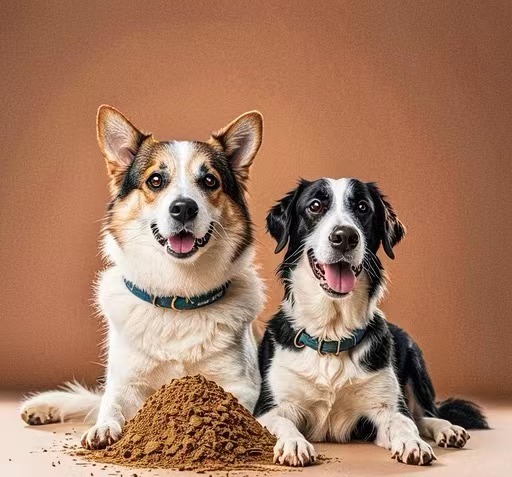
by TCMVET | May 15, 2024 | Dog Cancer & Tumors
Cancer in dogs is a challenging diagnosis for any pet owner. While traditional veterinary medicine offers surgery, chemotherapy, and radiation, many pet owners are also turning to holistic approaches, such as homeopathic remedies, to provide comfort and possibly extend the quality of life for their canine companions. This article explores the integration of homeopathic treatments with supportive care strategies to help dogs diagnosed with cancer.
Understanding Homeopathic Treatments for Canine Cancer
Homeopathy is a form of alternative medicine based on the principle of “like cures like,” which suggests that substances that produce symptoms in a healthy individual can treat similar symptoms in a sick individual when provided in highly diluted doses. For dogs with cancer, homeopathic remedies are tailored to the individual’s symptoms, rather than the disease itself.
Common homeopathic remedies used in the treatment of cancer in dogs include:
- Arsenicum Album: Often used for animals experiencing severe weakness, restlessness, and anxiety.
- Thuja Occidentalis: Generally recommended for growths stemming from vaccinations or other underlying issues.
- Belladonna: Suitable for cases with sudden onset of symptoms that are particularly intense and painful.
It’s crucial to consult with a veterinarian skilled in homeopathy to choose the appropriate remedy and dosage for your dog’s specific condition.
Supportive Care Strategies for Dogs with Cancer
Alongside homeopathic treatments, supportive care is vital in managing a dog’s quality of life with cancer. Here are some effective supportive care strategies:
- Nutrition: Feeding your dog a balanced diet tailored to their specific needs can help maintain strength and enhance their quality of life. Some pet owners opt for diets rich in antioxidants, omega-3 fatty acids, and easily digestible proteins.
- Pain Management: Traditional pain relief medications, acupuncture, and laser therapy are options to help manage pain effectively.
- Regular Exercise: Depending on the dog’s health and stamina, light to moderate exercise can help maintain muscle tone and stimulate their spirits.
- Emotional Support: Just like humans, dogs benefit from a supportive and loving environment. Maintaining a routine and spending quality time together can help lift a dog’s spirits.
Considerations and Precautions
While homeopathic remedies offer an alternative path, it’s essential to approach cancer treatment comprehensively. Always discuss any new treatment plans with a qualified veterinarian who understands both traditional and holistic approaches. Monitoring your dog’s response to any treatment and adjusting as necessary is crucial.
In conclusion, managing canine cancer involves a combination of medical intervention and compassionate care. Whether integrating homeopathy, adjusting dietary needs, or providing emotional support, the goal remains to enhance your dog’s quality of life and provide the best possible care during their treatment journey.

by TCMVET | May 14, 2024 | Dog Cancer & Tumors
As pet owners strive to enhance the health and longevity of their beloved dogs, they frequently turn to supplements and advanced medical treatments. This article delves into two significant areas of canine health: the benefits of collagen supplements for overall wellness, and cutting-edge treatments for brain tumors in dogs, providing a comprehensive guide for pet owners seeking the best care options.
The Benefits of Collagen for Dogs
Collagen, a vital protein found abundantly in the body, plays a crucial role in maintaining the integrity of cartilage, bones, and skin. As dogs age, their natural collagen production decreases, which can lead to joint issues and a decline in skin health. Supplementing with collagen can offer several benefits:
- Joint Health: Collagen helps to maintain the elasticity and strength of joints, potentially reducing the risk of arthritis.
- Skin and Coat Health: A robust supply of collagen can improve skin elasticity and coat health, giving dogs a shiny, healthy appearance.
- Digestive System Support: Collagen has been shown to help maintain the strength and integrity of the gut lining, aiding in digestion and overall gut health.
Selecting the best collagen supplement involves looking for products that are specifically tailored for pets, free from harmful additives, and sourced from high-quality ingredients.
Advances in Treating Canine Brain Tumors
Canine brain tumors can be a challenging diagnosis for any pet owner, but advancements in veterinary medicine have led to several promising treatments:
- Surgery: The primary treatment for accessible brain tumors in dogs is surgical removal, which can significantly improve quality of life if the tumor is operatively accessible.
- Radiation Therapy: For tumors that cannot be completely removed surgically, radiation therapy can help control the growth of the tumor.
- Chemotherapy: Depending on the type of brain tumor, chemotherapy may be used in conjunction with surgery and radiation to help reduce tumor size and prevent spread.
- Stereotactic Radiosurgery (SRS): This newer, highly precise form of radiation therapy targets the tumor with minimal damage to surrounding healthy tissue, offering a less invasive alternative to traditional surgery.
Combining Collagen Supplements with Cancer Treatment
While collagen itself does not treat brain tumors, using collagen supplements during cancer treatment can support a dog’s overall health, helping them better handle the rigors of surgery and recovery. It is essential to consult with a veterinarian to determine the best combination of treatments and supplements for a dog diagnosed with a brain tumor.
Understanding the role of collagen supplements in maintaining your dog’s health and keeping abreast of the latest treatments for serious conditions like brain tumors are vital steps in proactive pet care. By integrating the best of nutrition and modern veterinary medicine, pet owners can help ensure their dogs lead happy, healthy lives.

by TCMVET | May 14, 2024 | Dog Cancer & Tumors
In the ongoing quest for effective treatments for canine cancer, pet owners and veterinarians are increasingly turning to both traditional and innovative therapies. Among these, Si Miao San, a classic herbal formula from Traditional Chinese Medicine (TCM), has garnered attention for its potential benefits in treating various conditions, including cancer in dogs. This article explores the science behind Si Miao San, its application for canine health, and evaluates its role as a potential ‘miracle cure’ for dog cancer.
What is Si Miao San?
Si Miao San is a four-herb formula that has been used in Traditional Chinese Medicine for centuries. Originally designed to treat damp-heat conditions in humans, its applications have been successfully extended to pets, particularly dogs. The formula typically includes the following herbs:
- Atractylodes lancea (Cang Zhu): Known to help reduce inflammation and improve digestion.
- Phellodendron amurense (Huang Bai): Recognized for its anti-inflammatory and antibacterial properties.
- Coptis chinensis (Huang Lian): Celebrated for its ability to treat infections and soothe inflammation.
- Alisma plantago-aquatica (Ze Xie): Useful for its diuretic properties and its ability to help manage body fluids.
Si Miao San and Canine Cancer
Cancer in dogs often involves chronic inflammation and an imbalance in the body’s immune system. Si Miao San’s combination of herbs works synergistically to address these issues, making it a compelling option for supportive cancer care. Here’s how Si Miao San might help:
- Anti-inflammatory Properties: Many cancers are associated with inflammation. Si Miao San’s components like Huang Bai and Huang Lian are potent anti-inflammatories, which may help in reducing tumor-associated swelling and discomfort.
- Immune Modulation: The formula can modulate the immune system, potentially improving the body’s natural ability to fight cancer.
- Enhanced Quality of Life: By addressing secondary symptoms such as inflammation and poor digestion, Si Miao San can help improve the overall quality of life for dogs suffering from cancer.
Evaluating the Miracle Cure Claim
While Si Miao San shows promise in managing symptoms associated with cancer, it is important to maintain a balanced perspective. The term “miracle cure” can be misleading, as no single treatment guarantees a cure for cancer. Effective cancer treatment often requires a multifaceted approach, including conventional therapies like surgery, chemotherapy, and radiation, alongside supportive measures such as TCM.
Consultation with Veterinary Professionals
Before integrating Si Miao San into a dog’s cancer treatment regimen, it is crucial to consult with a veterinarian. Veterinarians who have experience in both conventional and holistic medicine can provide guidance tailored to an individual dog’s health condition.
Si Miao San offers a hopeful perspective for managing canine cancer, particularly when used as part of a comprehensive treatment plan. While not a miracle cure, its potential to improve quality of life and modulate the immune response in dogs is an avenue worth exploring for pet owners and veterinary practitioners alike. As research continues to evolve, so too will our understanding of how best to integrate traditional remedies like Si Miao San into modern veterinary care.

by TCMVET | May 13, 2024 | Dog Cancer & Tumors
In the world of pet health, cancer is a formidable adversary, but the ancient practices of Traditional Chinese Veterinary Medicine (TCVM) offer a unique perspective for early detection and management. This article explores how TCVM, with its deep roots in holistic health, can be applied to recognize early signs of cancer in dogs, providing a complementary approach alongside conventional veterinary science.
1. The Role of Five Element Theory
TCVM’s Five Element Theory—which correlates different body organs and systems to natural elements (wood, fire, earth, metal, water)—helps practitioners diagnose imbalances that could lead to diseases like cancer. For example, a liver imbalance, associated with the wood element, might manifest as jaundice or aggressive behavior, potentially signaling liver cancer.
2. Assessing Energy Levels and Body Condition
TCVM evaluates a dog’s vitality and body condition to detect illness. A significant change in energy or sudden weight change without a clear cause can be a sign of underlying health issues, including cancer. TCVM practitioners observe these changes within the context of the dog’s natural energy flow and overall health.
3. Diet and Cancer Correlation in TCVM
According to TCVM principles, diet plays a crucial role in maintaining health and preventing disease. A diet inappropriate for a dog’s constitutional type might lead to health issues. TCVM dietary therapy involves using specific foods that counteract the type of imbalance that could lead to cancer, such as cooling foods for a dog with excess internal heat.
4. TCVM Herbal Formulas for Prevention and Management
Herbal medicine is a cornerstone of TCVM and is used both for prevention and as a complementary therapy in cancer treatment. Herbs are selected based on their properties to target specific symptoms or disease mechanisms, such as herbs that move blood and Qi to prevent stagnation—a common precursor to tumor formation.
5. Integrative Diagnostic Approaches
While TCVM employs traditional diagnostic methods like pulse diagnosis and tongue analysis, integrating these with modern diagnostic tools such as blood tests and imaging studies can enhance the understanding and detection of cancer. This integrative approach allows for a thorough assessment, blending the best of both worlds.
A Holistic Pathway to Detection and Wellness
TCVM offers a holistic and integrative approach to the health challenges faced by dogs, including cancer. By focusing on the entire body and its energies, TCVM helps identify early signs of cancer that might be overlooked by conventional methods alone. For pet owners interested in a holistic approach, incorporating TCVM practices under the guidance of a qualified practitioner can provide an additional layer of support in maintaining their dog’s health and well-being.

by TCMVET | May 13, 2024 | Dog Cancer & Tumors
Cancer is a significant health issue for dogs, but early detection can be the key to effective treatment and management. As a responsible pet owner, being aware of the various signs of cancer can help you take swift action to potentially save your dog’s life. This article outlines distinct signs of cancer in dogs and offers preventive measures to help reduce the risk.
1. Behavioral Changes
Sudden changes in behavior can be a telltale sign of discomfort or pain associated with cancer. If your dog is less social, more irritable, or exhibits unusual aggression, it may be time to consult your veterinarian.
2. Sores That Do Not Heal
Persistent sores or wounds that don’t heal, despite treatment, can be indicative of cancer. These sores may frequently bleed or discharge and should be examined by a professional.
3. Difficulty Eating or Swallowing
If your dog suddenly has trouble eating, swallowing, or seems to choke on their food, this could be a sign of oral cancer or cancer in the neck and head area. These symptoms often lead to noticeable weight loss and should not be overlooked.
4. Elimination Issues
Watch for difficulties with urination or defecation, such as straining, blood in urine or feces, or a change in bowel movement consistency. These can be symptoms of digestive or urinary tract cancer.
5. Breathlessness or Endurance Issues
A decrease in stamina, evident when your dog plays or exercises, or an increase in breathlessness could signal heart or lung issues potentially related to cancer.
6. Seizures
Unexplained seizures can be associated with brain tumors in dogs, especially in older pets. Any sudden onset of seizures should prompt an immediate veterinary evaluation.
Preventive Measures:
- Balanced Diet: Feeding your dog a balanced, nutrient-rich diet can help boost their immune system and potentially ward off cancer.
- Regular Exercise: Keeping your dog active helps maintain a healthy weight and supports overall health, reducing cancer risks.
- Environmental Management: Reduce your dog’s exposure to toxins and carcinogens, such as second-hand smoke, lawn chemicals, and hazardous household cleaners.
- Genetic Testing: For breeds prone to specific cancers, genetic testing can inform you about potential risks and facilitate early surveillance.
Understanding these signs and implementing preventive measures can dramatically affect your dog’s health and longevity. If you observe any of the above symptoms, a visit to the vet is crucial for early diagnosis and potentially more successful treatment. Stay proactive about your dog’s health to give them the best chance against cancer.

by TCMVET | May 11, 2024 | Dog Cancer & Tumors
In the quest to provide our furry friends with a longer, healthier life, the convergence of Traditional Chinese Veterinary Medicine (TCVM) and modern science offers promising alternatives for cancer care. This article explores the potent benefits of TCVM, specifically focusing on cancer-fighting supplements that have been used for centuries to support canine health.
Understanding Traditional Chinese Veterinary Medicine
Traditional Chinese Veterinary Medicine is an ancient practice that focuses on restoring balance and enhancing the body’s natural healing abilities. It employs a holistic approach to health, emphasizing the prevention and treatment of diseases through methods like herbal medicine, acupuncture, food therapy, and Tui-na (a form of therapeutic massage).
1. Herbal Medicine: TCVM utilizes a variety of herbs that are believed to possess properties capable of combating cancer. These herbs are often administered as supplements and are tailored to the individual needs of the dog, considering the type of cancer, the stage of the disease, and the overall health of the animal.
2. Integrative Approach: Many veterinarians combine TCVM with conventional cancer treatments such as chemotherapy and radiation. This integrative approach can help minimize side effects, improve quality of life, and potentially enhance the efficacy of conventional treatments.
Cancer-Fighting Supplements in TCVM
TCVM offers a range of herbal supplements that are thought to fight cancer by boosting the immune system, inhibiting tumor growth, and improving overall vitality. Here are some key supplements commonly used in canine cancer care:
1. Yunnan Baiyao: This herbal supplement is renowned for its ability to stop bleeding and is often used in cases of cancer that involve internal bleeding. Additionally, it is believed to help reduce tumors.
2. Huang Qin (Scutellaria baicalensis): Known for its anti-inflammatory properties, Huang Qin is used to treat gastrointestinal distress and to protect against certain types of cancer.
3. Jiaogulan (Gynostemma pentaphyllum): This herb is recognized for its adaptogenic properties, helping to boost the immune system and increase antioxidant activity, which can be crucial for dogs undergoing cancer treatment.
Practical Application of TCVM in Cancer Care
The application of TCVM in treating canine cancer involves a thorough evaluation by a veterinarian trained in traditional Chinese medicine. This includes a detailed assessment of the dog’s symptoms, lifestyle, and overall health to create a personalized treatment plan.
1. Case Studies: Numerous case studies have shown that dogs treated with TCVM in addition to conventional therapies often experience improved outcomes, such as increased survival times and enhanced quality of life.
2. Ongoing Research: While empirical evidence supports the benefits of TCVM, ongoing research continues to explore its effectiveness and mechanisms of action, aiming to integrate these ancient practices more firmly into mainstream veterinary medicine.
Traditional Chinese Veterinary Medicine provides a complementary approach to conventional cancer treatment in dogs. By incorporating cancer-fighting supplements and holistic care techniques, TCVM can play a crucial role in managing canine cancer, ultimately leading to better health outcomes and a higher quality of life for our beloved pets. As we embrace these ancient practices, it is essential to do so under the guidance of a qualified veterinarian to ensure safety and efficacy.







